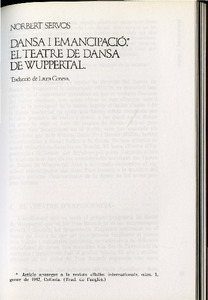| dc.contributor.author | Servos, Norbert | |
| dc.date.accessioned | 2022-12-30T16:13:30Z | |
| dc.date.available | 2022-12-30T16:13:30Z | |
| dc.date.issued | 1984 | |
| dc.identifier.issn | 2385-362X | |
| dc.identifier.issn | 0212-3819 | |
| dc.identifier.uri | http://hdl.handle.net/20.500.11904/1365 | |
| dc.description.abstract | <p>When Pina Bausch took over the direction of the Wuppertal Dance Theatre in the 1973-1974 season, German ballet broke off in a new direction. Her work grew steadily more distanced from the dance concepts of classical ballet and modern dance; she created a mixed genre, made up of genuine theatre and dance forms used in a different way and dubbed “Dance Theatre”. She is clearly a new didactic artist rooted in Brecht. The device “Experience Theatre” underlines the way in which the Wuppertal Dance Theatre should be taken and defines the emancipating signification that Pina Bausch gives to all the artistic genre: the emancipation of dance from its own forms. In this article Norbert Servos introduces and studies Pina Bausch's work in three chapters (The “Experience Theatre”; The forms of the “new” Dance Theatre, and The Language and History of the Body) and relates them to the theories of Ernest Bloch and Norbert Elias.</p> | |
| dc.relation.ispartof | Estudis escènics: quaderns de l'Institut del Teatre. 1984, Núm. 24 | |
| dc.title | Dansa i emancipació: el teatre de dansa de Wuppertal | |
| dc.type | Article | |
| dc.date.updated | 2022-12-30T16:13:31Z | |
| dc.rights.access | Open Access | |


